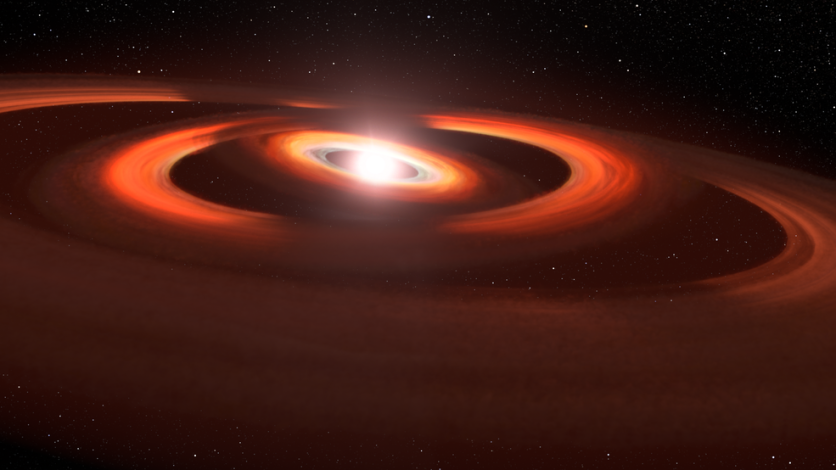In a cosmic game of shadow puppets, the Hubble Space Telescope has captured a young star in the act.
TW Hydrae, a red dwarf star less than 10 million years old, has been observed playing peek-a-boo with two shadows cast by disks of gas and dust that surround it.
This spectacle has left scientists in awe and excitement, as they believe it could be evidence of a pair of planets in the process of construction.

Mysterious Shadow in 2017
In the vast expanse of space, a mysterious shadow was first detected in 2017, and the discovery puzzled astronomers. The shadow was created by an inner disk that was slightly askew relative to the much larger outer disk, causing it to cast a dark silhouette on the face of the pancake-shaped gas-and-dust disk.
The peculiar occurrence led scientists to speculate that an invisible planet was exerting gravitational force, pulling dust and gas into its orbit.
But the cosmic enigma deepened when a second shadow emerged, revealing a whole new level of intricacy to the phenomenon. These two disks are thought to be stand-ins for planets, swirling around each other as they circle the star.
However, it was not until June 6, 2021, that astronomers were finally able to fit the pieces of the cosmic puzzle together.
Led by John Debes of AURA/STScI for the European Space Agency (ESA) at the Space Telescope Science Institute in Baltimore, Maryland, the team uncovered the new shadow, and Debes was left in awe.
The experience was described as "flummoxing" and "mind-blowing," as the second shadow behaved entirely differently than the first.
Read also: Starry Pair: NASA's Hubble Captures Stunning Portrait of Spiral Galaxies Resembling Milky Way
A Second Shadow
The discovery of a second shadow in the TW Hydrae system has added a new level of complexity to the cosmic mystery. The best explanation from astronomers is that two planets are responsible for the misaligned disks and shadows, each in a slightly different orbital plane, located at roughly the distance of Jupiter from our Sun.
These planets complete one rotation around the star about every 15 years. The inner disks are inclined about five to seven degrees relative to the plane of the outer disk, which is similar to the range of orbital inclinations in our solar system, according to NASA.
The disk where the shadows are observed is believed to be much larger than our solar system's Kuiper belt, and it contains a gap at twice the distance of Pluto from the Sun, which suggests a third planet's presence.
NASA notes that detecting inner planets is challenging due to the star's glare and dust, but ESA's Gaia space observatory could detect star wobbles if Jupiter-sized planets are present, while the James Webb Space Telescope may provide a closer look at the shadows with its infrared capabilities.
The discovery provides a unique opportunity to learn more about the formation of planets and solar systems, as well as the conditions that give rise to life.
As the cosmic dance continues, astronomers will eagerly await the next act in this spectacular show.
Related Article : NASA Hubble Discovers Saturn's Ring System Heats Planet's Atmosphere-A Never-Before-Seen Phenomenon!

ⓒ 2026 TECHTIMES.com All rights reserved. Do not reproduce without permission.




